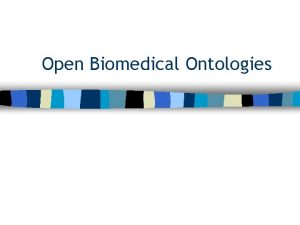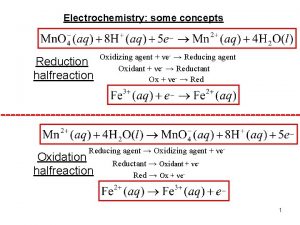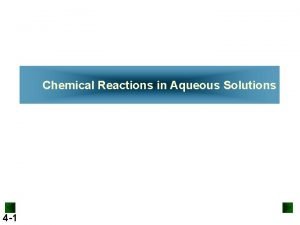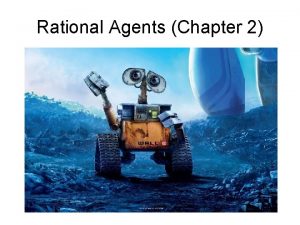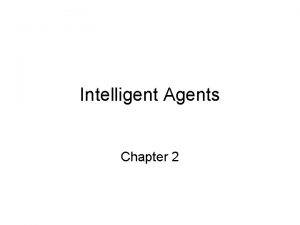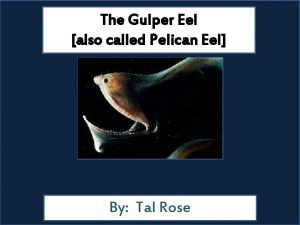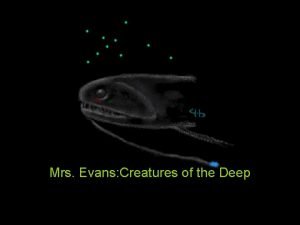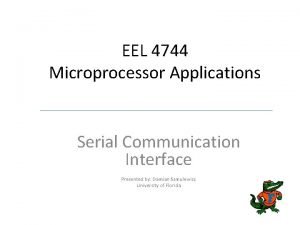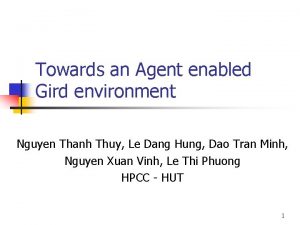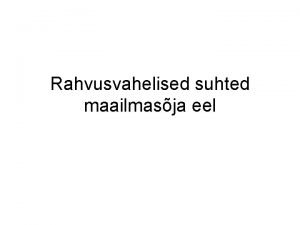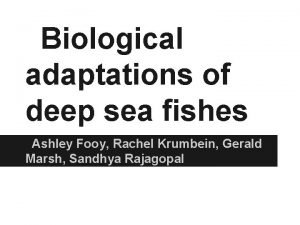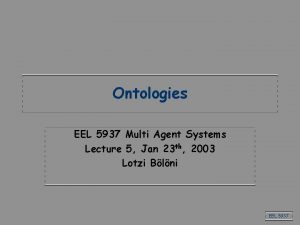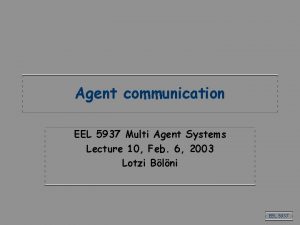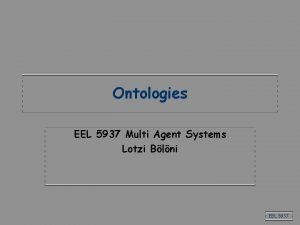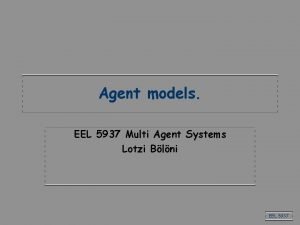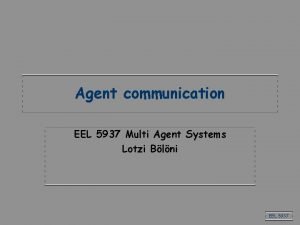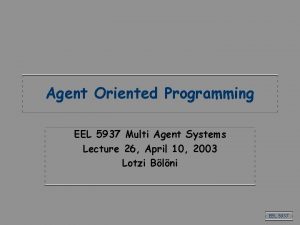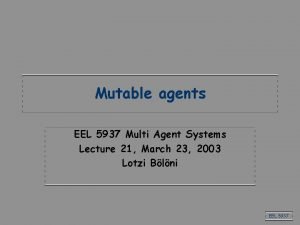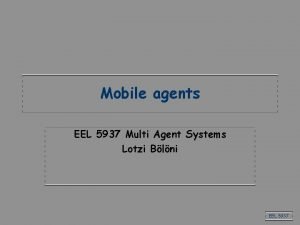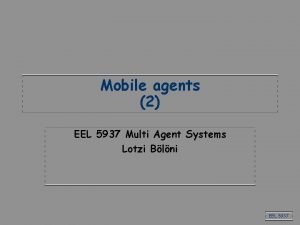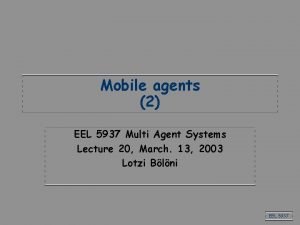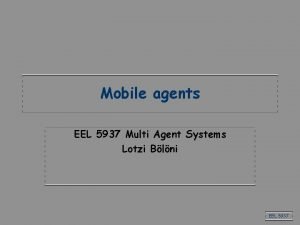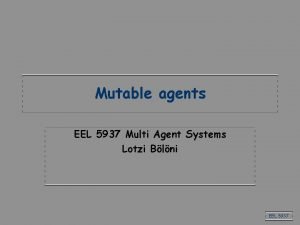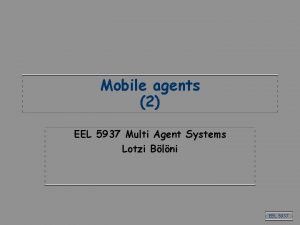Ontologies EEL 5937 Multi Agent Systems Lecture 5

















- Slides: 17

Ontologies EEL 5937 Multi Agent Systems Lecture 5, Jan 23 th, 2003 Lotzi Bölöni EEL 5937

Ontologies • Ontologies are explicit formal specifications of the terms in the domain and relations among them (Gruber 1993). • Why would someone want to develop an ontology? Some of the reasons are: – To share common understanding of the structure of information among people or software agents – To enable reuse of domain knowledge – To make domain assumptions explicit – To separate domain knowledge from the operational knowledge – To analyze domain knowledge EEL 5937

What is an ontology? • Classes (sometimes called concepts) • Slots (sometimes called roles or properties) • Facets, restrictions on slots (sometimes called role restrictions). • An ontology together with a set of individual instances of classes constitutes a knowledge base. – In reality, there is a fine line where the ontology ends and the knowledge base begins. -This representation is closely related to the frame approach of Marvin Minsky (1975). -They are also closely related to semantic networks -Also related to: OOP, Database systems etc. -There can be variations from this basic pattern EEL 5937

Ontology systems • Languages – – – CLIPS, Jess XML RDF DAML+OIL Cyc. L • Ontology editors – Protégé-2000 • Standardized ontologies – Dublin Core Ontology – Cyc Upper Ontology – … etc. EEL 5937

Resource Description Framework EEL 5937

RDF – Resource Description Framework • RDF is proposed by W 3 C – the Internet standardization organization (and Tim-Berners Lee) • provides a language for modeling semi-structured metadata and enabling knowledge-management applications. • RDF is very similar to a basic directed graph, which is a very well understood data structure in computer science. • This simplicity serves RDF very well, making it a sort of assembly language on top of which almost every other information-modeling method can be overlaid. EEL 5937

RDF (cont’d) • The Resource Description Framework (RDF) is a language for representing information about resources in the World Wide Web. It is particularly intended for representing metadata about Web resources, such as the title, author, and modification date of a Web page, copyright and licensing information about a Web document, or the availability schedule for some shared resource. However, by generalizing the concept of a "Web resource", RDF can also be used to represent information about things that can be identified on the Web, even when they can't be directly retrieved on the Web. RDF provides a common framework for expressing this information so it can be exchanged between applications without loss of meaning. EEL 5937

RDF (example) <rdf: RDF xmlns: rdf="http: //www. w 3. org/1999/02/22 -rdf-syntax-ns#" xmlns="http: //www. w 3. org/2000/10/swap/pim/contact#"> <Person rdf: about="http: //www. w 3. org/People/EM/contact#me"> <full. Name>Eric Miller</full. Name> <mailbox rdf: resource="mailto: em@w 3. org"/> <personal. Title>Semantic Web Activity Lead</personal. Title> </Person> </rdf: RDF> EEL 5937

RDF terminology • An RDF document is a collection of statements. • A statement is a triplet of (subject, predicate, object). • Subject: the thing the statement is about. • Predicate: the property or the characteristic of the subject that the statement identifies • Object: the value of the property. • E. g. : http: //www. example. org has a creator whose value is John Smith. EEL 5937

RDF: Uniform Resource Identifiers • URIs are not limited to identifying things that have network locations, or use other computer access mechanisms. In fact, we can create a URI to refer to anything we want to talk about, including • network-accessible things, such as an electronic document, an image, a service (e. g. , "today's weather report for Los Angeles"), or a collection of other resources. • things that are not network-accessible, such as human beings, corporations, and bound books in a library. • abstract concepts that don't physically exist, like the concept of a "creator". EEL 5937

URI: examples: • http: (Hypertext Transfer Protocol, primarily for Web pages) • mailto: (email addresses), e. g. , mailto: em@w 3. org • ftp: (File Transfer Protocol) • urn: (Uniform Resource Names, intended to be persistent location-independent resource identifiers), e. g. , urn: isbn: 0 -520 -02356 -0 (for a book) EEL 5937

URI Reference • A URI reference (or URIref) is a URI, together with an optional fragment identifier at the end. For example, the URI reference • http: //www. example. org/index. html#section 2 • consists of the URI http: //www. example. org/index. html and (separated by the "#" character) the fragment identifier Section 2. • RDF defines a resource as anything that is identifiable by a URI reference, and hence using URIrefs allows RDF to describe practically anything, and to state relationships between such things as well. • In order to make writing URIrefs easier, URIrefs may be either absolute or relative. EEL 5937

RDF Reification • RDF applications sometimes need to make statements about statements, for instance, to record information about when a statement was made, who made it, or other similar information • That is, we want to be able to turn the original statement into a resource, so that we can make it the subject of another RDF statement that talks about it. RDF provides a built-in vocabulary for modeling statements as resources. This modeling is called reification in RDF, and a model of a statement is called a reified statement. EEL 5937

DAML EEL 5937

DAML • Users have desired more from RDF and RDF Schema, including data types, a consistent expression for enumerations, and other facilities EEL 5937

DAML extensions to RDF • Data typing, multiple ranges • Unique properties – One can specify that a property be unique, meaning that there can only be one value of the property for each instance • Enumerations – Closed set of values • Inverse properties – Inverse properties are quite common. If A is the father of B, then B is the child of A. The properties "father" and "child" are the inverse of each other. DAML+OIL allows one to declare this systematically, so that you are free to only assert one property, and its inverse is inferred. • Transitivity – Another important specialization of properties in DAML+OIL is transitivity. For instance, the ancestor of your ancestor is also your ancestor. There is at least one common transitive property built into RDFS: daml: sub. Class. Of. If class A is a subclass of B, and class B is a subclass of C, then class A must be a subclass of C. DAML+OIL allows one to give this behavior to any object property one wishes EEL 5937

DAML extensions to RDF (cont’d) • Property Restrictions – For many reasons ranging from convenience to access control, one might not directly assert a classification for a resource. DAML+OIL provides property restrictions, which are a way to restrict classes to a set of resources based on particular properties of theirs, the number of these properties that are asserted, or the value of these properties. EEL 5937
 Open biomedical ontologies
Open biomedical ontologies 01:640:244 lecture notes - lecture 15: plat, idah, farad
01:640:244 lecture notes - lecture 15: plat, idah, farad Multi channel multi phase example
Multi channel multi phase example Multi loop pid controller regolatore pid multi loop
Multi loop pid controller regolatore pid multi loop Difference between oxidation and reduction
Difference between oxidation and reduction Standard reduction potential table
Standard reduction potential table Redox reaction in alkaline medium
Redox reaction in alkaline medium Agent function vs agent program
Agent function vs agent program Peas description for part-picking robot
Peas description for part-picking robot Alice drablow quotes
Alice drablow quotes Pelican eel habitat
Pelican eel habitat Tripod fish
Tripod fish Eel 4744
Eel 4744 Nguyen
Nguyen Rahvusvaheline olukord teise maailmasõja eel
Rahvusvaheline olukord teise maailmasõja eel Eel 3705
Eel 3705 Usp
Usp Hatchetfish adaptations
Hatchetfish adaptations
